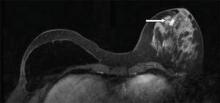CHICAGO – Women with a personal history of breast cancer should be advised to consider an annual screening breast MRI as an adjunct to mammography, despite the American Cancer Society’s current position that there is insufficient evidence to recommend for or against it, according to a retrospective review from the University of Washington Medical Center, Seattle.
“We found that the diagnostic performance of screening breast MRI was similar to or higher overall in women with a personal history [of breast cancer] alone, compared to those with a genetic or family history, the latter being the group currently recommended for screening by the American Cancer Society,” said lead author Dr. Wendy B. DeMartini of the University of Washington. Dr.
DeMartini presented her results Nov. 28 at the annual meeting of the Radiological Society of North America.
American Cancer Society guidelines recommend an annual screening with breast MRI as an adjunct to mammography for women with a genetic or family history of breast cancer, but not for those with a personal history of the disease. MRI is highly sensitive and allows early detection of otherwise occult breast carcinoma, and mammography is an imperfect tool for detection, Dr. DeMartini said. This is critical in women with a personal history of treated breast cancer because they are at elevated risk for a second cancer, and finding second cancers early increases their chance of survival. “Annual screening with MRI may be important in this group,” she said.
Disadvantages of MRI include the use of intravenous contrast material, the potential for false positives, and increased cost.
 Photo credit: RSNA
Photo credit: RSNA
Breast MRI from the same patient shows a 15 mm irregular mass (arrow) in the left breast, not noticeable on the mammogram. Subsequent biopsy of the mass was performed under MRI guidance and yielded invasive breast cancer. The right breast demonstrates normal findings of mastectomy with implant reconstruction.
The American Cancer Society’s most recent guidelines issued in 2007 recommend annual screening MRI in addition to mammography for women in two high-risk groups: those with genetic mutation such as the BRCA gene or first-degree relatives with the gene and those with greater than or equal to 20%-25% lifetime risk, based on family history. The guidelines concluded that there was insufficient evidence to recommend for or against breast MRI in patients with only a personal history of the disease but no genetic or family risk.
“And thus it’s been quite challenging as you can imagine for women and their physicians to know whether these breast cancer survivors should be having breast MRI once a year with their mammograms,” she said.
This study was designed to compare the diagnostic performance of screening breast MRI in women with a personal history of treated breast cancer alone, to that in women with a genetic or family history of breast cancer.
A retrospective review of the University of Washington’s electronic medical database identified all women who underwent a first screening breast MRI for a clinical indication and had either a personal history or genetic or family history of breast cancer during the period January 2004 – June 2009. Each patient contributed their first screening breast MRI to the study. For each examination, the highest level final breast imaging-reporting and data system (BI-RADS) assessment was used. Cancer status was followed for 365 days following index breast MRI and was considered positive if there was a diagnosis of invasive carcinoma or ductal carcinoma in situ.
Measures of diagnostic performance that were calculated included the recall rate, or number of women recalled for additional testing; the positive predictive value for malignancy at biopsy; the cancer yield, or percent found to be malignant among those screened; and the sensitivity and specificity.
Of the 1,026 women who underwent a first screening breast MRI in the study interval, 973 were screened for personal history and/or genetic or family history. These made up the study population. Of these, 646 (66%) were screened for personal history alone, and the remaining 327 (34%) were screened for genetic or family history. Women who fell into both categories were classified as genetic or family history.
In the 973 women, 27 malignancies were found, said Dr. DeMartini. “Twenty-five of them were found with breast MRI,” she said. The other two were not found with breast MRI and were false negatives; both occurred in the personal history group. Of the 25 malignancies, MRI detected 20 in the personal history group and 5 in the genetic family group, she said.


